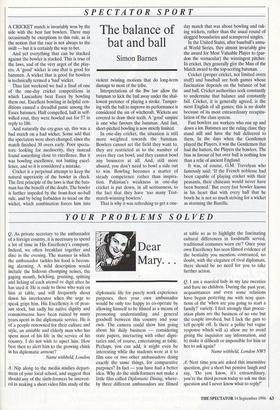SPECTATOR SPORT
The balance of bat and ball
Simon Barnes
A CRICKET match is invariably won by the side with the best fast bowlers. There may occasionally be exceptions to this rule, as in the notion that the race is not always to the swift — but it is certainly the way to bet.
And yet everything that can be stacked against the bowler is stacked. This is true of the laws, and of the very argot of the play- ers. A 'good' wicket is one that is good for batsmen. A wicket that is good for bowlers is technically termed a 'bad' wicket.
Thus last weekend we had a final of one of the one-day cricket competitions in which Lancashire beat Essex by bowling them out. Excellent bowling in helpful con- ditions caused a dreadful panic among the Essex batsmen. Half compelled, half in self- willed rout, they were bowled out for 57 in reply to 186.
And naturally the cry goes up, this was a bad match on a bad wicket. Some add that the spectators were short-changed, since the match finished 30 overs early. Poor specta- tors: looking for mediocrity, they instead found something close to excellence. But it was bowling excellence, not batting excel- lence, and so it is considered a mistake. Cricket is a perpetual attempt to keep the natural superiority of the bowler in check. The first principle of the laws is that the bats- man has the benefit of the doubt. The bowler is further impeded by the front-foot no-ball rule, and by being forbidden to tread on the wicket, which combination forces him into violent twisting motions that do long-term damage to most of the tribe.
Interpretations of the lbw law allow the batsman to kick the ball away under the shal- lowest pretence of playing a stroke. Tamper- ing with the ball to improve its performance is considered the sin of witchcraft. Wickets are covered to draw their teeth. A 'good' umpire is one who favours the batsman. And fast, short-pitched bowling is now strictly limited. In one-day cricket, the situation is still more weighted towards the batsman. Bowlers cannot set the field they want to, they are restricted as to the number of overs they can bowl, and they cannot bowl any bouncers at all. And, still more absurd, you don't need to bowl a side out to win. Bowling becomes a matter of steady competence rather than inspira- tion. Pakistan's weakness in one-day cricket is put down, in all seriousness, to the fact that they have 'too many Test- match-winning bowlers'.
That is why it was refreshing to get a one- day match that was about bowling and tak- ing wickets, rather than the usual round of slogged boundaries and scampered singles. In the United States, after baseball's annu- al World Series, they almost invariably give the award for Most Valuable Player to (par- don the vernacular) the winningest pitcher. In cricket, they generally give the Man of the Match award to the top-scoring batsman. Cricket (proper cricket, not limited overs stuff) and baseball are both games whose fascination depends on the balance of bat and ball. Cricket authorities seek constantly to undermine that balance and constantly fail. Cricket, it is generally agreed, is the most English of all games; this is no doubt because of its most extraordinary recapitu- lation of the class system.
Fast bowlers are workers who run up and down a lot. Batsmen are the ruling class; they stand still and have the ball delivered to them. In the days when the Gentlemen played the Players, it was the Gentlemen that had the batters, the Players the bowlers. The bias in favour of bat over ball is nothing less than a relic of ancient England.
It was, of course, G.M. Trevelyan who famously said: 'If the French noblesse had been capable of playing cricket with their peasants, their châteaux would never have been burned.' But every fast bowler knows in his heart that with every ball that he bowls he is not so much striving for a wicket as storming the Bastille.


































































 Previous page
Previous page